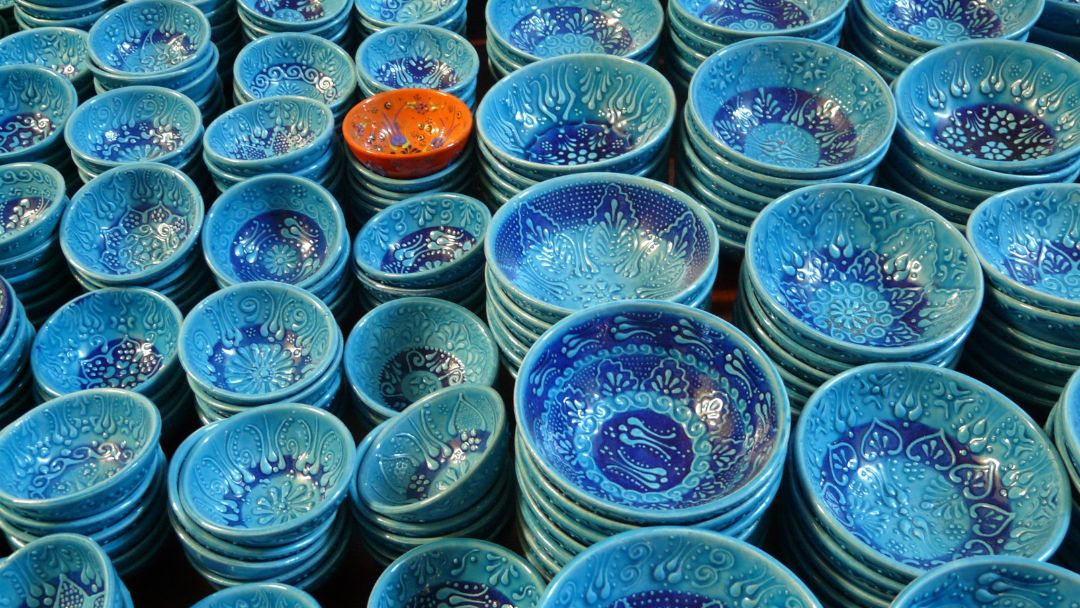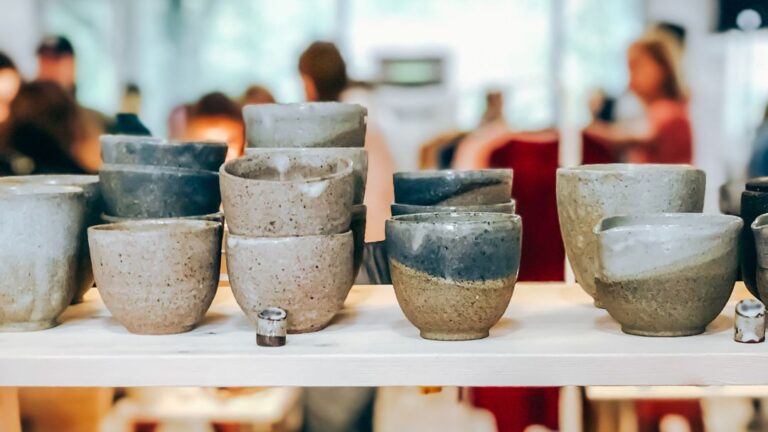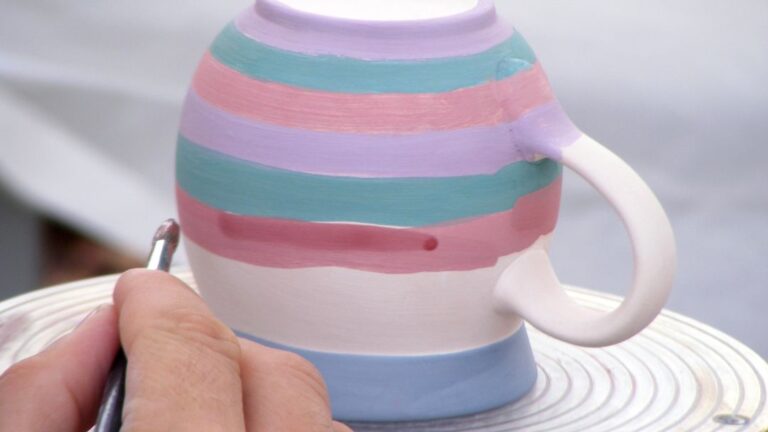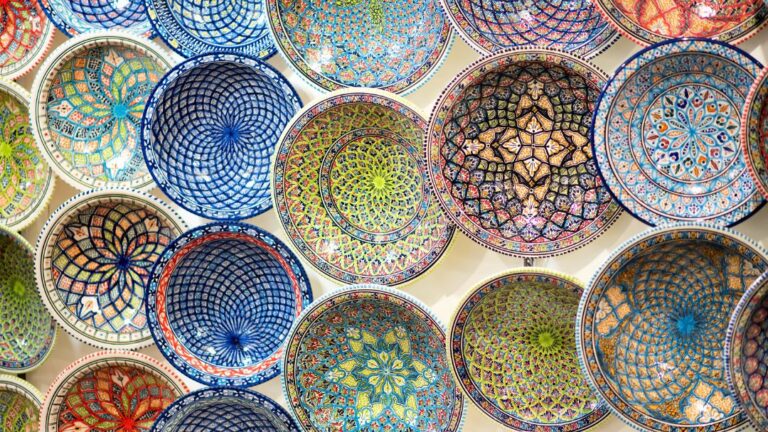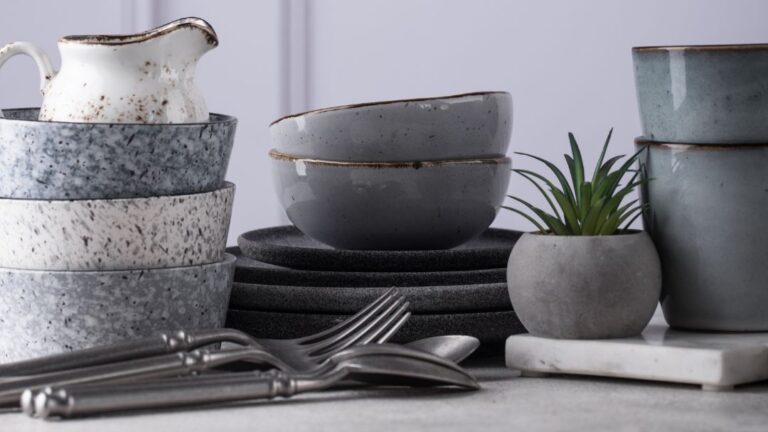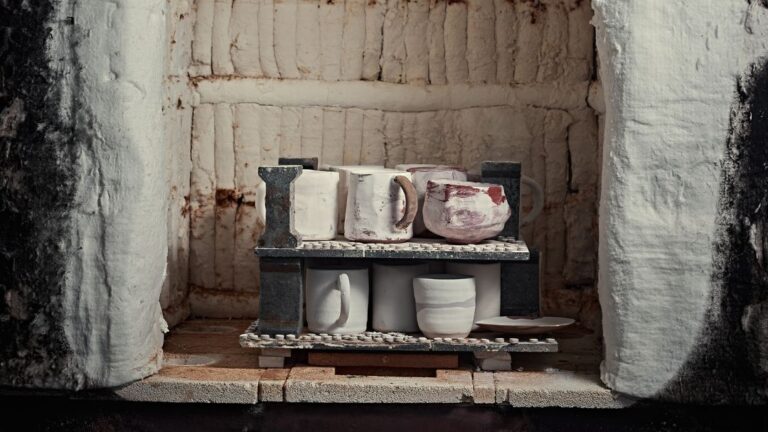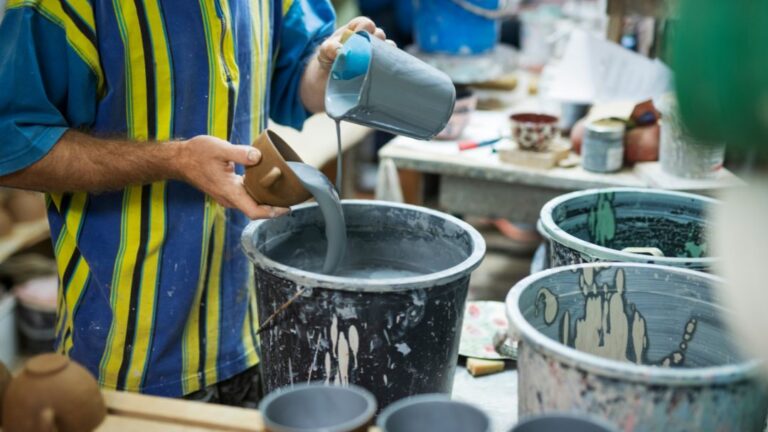What is Glaze for Pottery?
Glaze for pottery is a type of liquid coating applied to clay objects before firing to create a smooth, glossy, and colorful surface. The glaze is made by combining various minerals and chemicals and can be translucent or opaque.
It enhances the appearance of the pottery and also adds functionality by making it waterproof and resistant to staining.
The Basics Of Pottery Glaze
Pottery glaze is a vital element in creating beautiful and functional ceramic pieces. It is a liquid mixture of minerals and pigments that, when fired in a kiln, forms a glass-like coating on the surface of the pottery. This glaze not only adds color and texture but also provides a protective layer, making the pottery durable and waterproof.
Pottery glaze is a crucial element in the world of ceramics. It not only enhances the aesthetic appeal of pottery but also plays a vital role in protecting the final piece. Whether you’re a pottery enthusiast or just curious about the art form, understanding the basics of pottery glaze is essential.
In this section, we’ll explore the definition of pottery glaze, its importance, the historical background of glazing techniques, and the common types of glazes used in pottery.
Definition Of Pottery Glaze
- Glaze refers to a thin and glass-like coating that is applied to pottery before firing.
- It is composed of various minerals, chemicals, and pigments that melt and fuse during the firing process, resulting in a smooth and glossy surface.
Importance Of Glaze In Pottery
- Protection: Glaze acts as a protective barrier for the pottery, preventing moisture from seeping into the clay and damaging the piece.
- Enhancement: It adds color, texture, and visual interest to the pottery, allowing artists to express their creativity.
- Durability: Glaze increases the durability and strength of pottery, making it more resistant to scratches and wear over time.
Historical Background Of Glazing Techniques
- Glazing techniques have been used in pottery for centuries, dating back to ancient civilizations such as the Egyptians, Greeks, and Chinese.
- Initially, glazes were limited to simple earthenware pots, but over time, the techniques evolved to create more intricate and vibrant designs.
- Different regions developed their unique glazing styles, such as the celadon glazes of Korea and the majolica glazes of Italy.
Common Types Of Glazes Used In Pottery
- Earthenware glazes: These glazes are low-fired and typically produce a porous surface. They are known for their vibrant colors and can range from glossy to matte finishes.
- Stoneware glazes: These glazes are high-fired and result in a dense and non-porous surface. They offer a broader range of colors, from earth tones to deep blues and greens.
- Porcelain glazes: These glazes are fired at exceptionally high temperatures, resulting in a translucent and glass-like finish. They are known for their elegant and delicate appearance.
Understanding the basics of pottery glaze helps us appreciate the skill and craftsmanship behind each unique piece. Whether it’s the functional pottery we use daily or the decorative art that adorns our homes, glazing techniques play a significant role in shaping the final outcome.
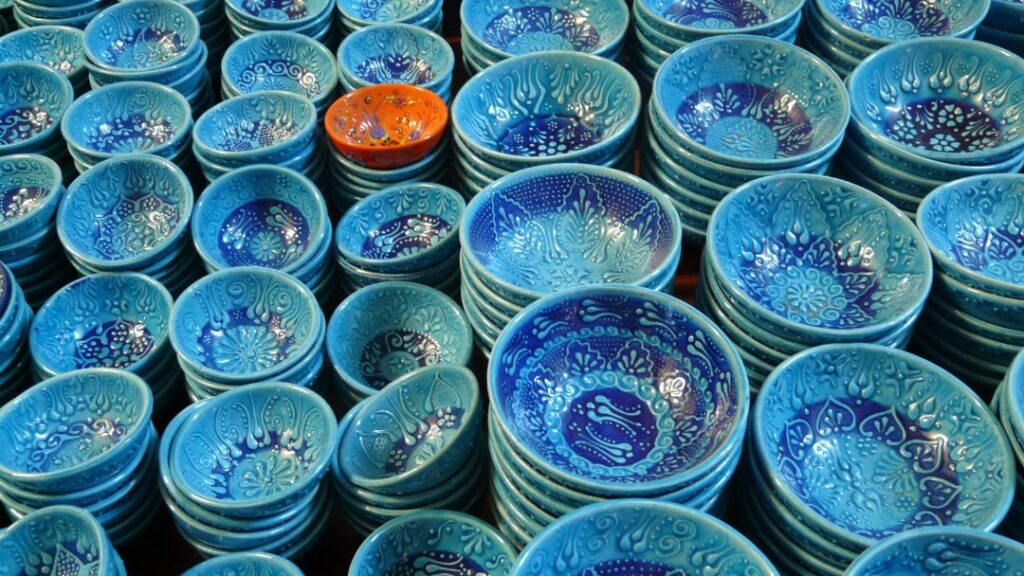
Components Of Pottery Glaze
Pottery glaze consists of various components, including silica, fluxes, and colorants, that are mixed together to create a liquid coating for ceramics.
Understanding The Ingredients Of A Glaze
In the fascinating world of pottery, glazes are an essential element that brings life and character to ceramic artworks. Glaze is a substance that, when applied to pottery and fired in a kiln, forms a glassy and decorative coating. But have you ever wondered what makes up this magical concoction?
Let’s dive into the components of pottery glaze and explore their roles.
Role Of Silica, Alumina, Flux, And Colorants In Glazes
The success of a glaze recipe lies in its components, each playing a crucial role in the transformation of raw clay into a glistening masterpiece. Here are the main players:
- Silica: Acts as a glass-forming agent in the glaze, contributing to its smooth and shiny appearance. With its high melting point, silica helps the glaze melt and adhere to the pottery during firing.
- Alumina: Balances the fluxing agents in the glaze and enhances its durability. Alumina also aids in the prevention of glaze defects, such as crazing or cracking.
- Flux: These materials, such as feldspar or boron compounds, play a vital role in lowering the melting point of the glaze. Flux ensures that the glaze melts smoothly and evenly during the firing process, creating a glossy finish on the pottery.
- Colorants: As the name suggests, colorants are responsible for adding vibrant hues to the glaze. Various oxides and stains, such as cobalt oxide for blue or iron oxide for brown, are mixed into the glaze to achieve desired colors.
How Different Components Affect The Outcome Of Glazing
Now that we know the key components, let’s uncover how they influence the outcome of glazing:
- Silica content: A higher silica content produces a more matte glaze, while a lower content creates a glossy finish.
- Alumina ratio: Higher levels of alumina give the glaze a matte appearance, whereas lower levels result in a glossy surface.
- Flux proportions: Altering the ratio of flux materials affects the glaze’s melting point and fluidity, leading to variations in the final texture and appearance.
- Colorant types and quantities: Different colorants and their concentrations influence the intensity, hue, and opacity of the glaze color.
By carefully manipulating these components, potters can create an endless array of glaze types, from opaque to transparent, glossy to matte, and muted to vibrant colors. The harmonious interplay of silica, alumina, flux, and colorants unlocks the power of glazing, allowing artists to elevate their pottery to remarkable heights.
So, the next time you marvel at a beautifully glazed ceramic piece, take a moment to appreciate the artistry and craftsmanship behind its components. After all, glazes are the secret behind pottery’s enchanting allure.
Glaze Application Techniques
Glaze application techniques enhance pottery by adding a glossy and protective coating through the use of various methods. These techniques result in unique finishes that bring out the beauty of the pottery.
Overview Of Various Glazing Methods
Pottery glaze is essentially a liquid mixture that transforms into a glass-like finish when fired in a kiln. There are several techniques for applying glaze to pottery, each offering its own unique effects and benefits. Understanding these methods can help you achieve the desired look and quality in your glazed pottery.
Let’s explore some of the most common glaze application techniques.
Dip Glazing And Its Benefits
Dip glazing involves submerging the entire piece of pottery into a container filled with glaze. This technique offers several advantages, including:
- Fast and efficient application: By fully immersing the pottery into the glaze, you can achieve even coverage in a shorter amount of time.
- Consistent finish: Dip glazing ensures that all surfaces of the pottery receive the same amount of glaze, resulting in a uniform appearance.
- Controlled layering: With dip glazing, you can easily achieve multiple layers of glaze by dipping and firing the pottery multiple times.
Brushing Glaze On Pottery
Brushing glaze is a popular technique that involves applying glaze to pottery using a brush. Here are some key aspects of brushing glaze:
- Precision control: Brushing allows for detailed and precise application, making it ideal for intricate designs or specific areas of the pottery.
- Layering possibilities: With brushing glaze, you can easily layer different colors or glazes, creating unique and customizable effects.
- Gradual buildup: By steadily applying glaze with a brush, you can gradually build up layers and control the thickness of the glaze.
Spraying And Pouring Techniques
Spraying and pouring are two alternative methods for applying glaze that offer distinct outcomes:
- Spraying: Using a spray gun or airbrush, you can achieve a fine mist of glaze that evenly coats the pottery’s surface. This method allows for even coverage and smooth finishes.
- Pouring: Pouring glaze over the pottery creates dynamic and unpredictable patterns. This technique is especially effective for achieving flowing or marbled effects.
Tips For Achieving Even And Smooth Glaze Application
To ensure a successful and aesthetically pleasing glaze application, consider the following tips:
- Clean pottery: Make sure your pottery is free from dust or any contaminants before applying glaze.
- Consistency of glaze: Stir or mix your glaze thoroughly to achieve a smooth and consistent consistency before application.
- Test and practice: Experiment with test pieces and different glaze combinations to familiarize yourself with how they react and interact during firing.
- Multiple layers: Consider applying multiple layers of glaze to achieve depth and richness in the finish.
- Glaze thickness: Be mindful of the thickness of the glaze to avoid drips, pooling, or unevenness.
- Firing temperature: Follow the recommended firing temperature for your specific glaze to achieve the desired results.
By understanding these various glazing techniques and implementing the tips mentioned, you can enhance your pottery creations with beautiful and professional glaze finishes.

Glaze Firing And Temperature
Glaze firing and temperature are essential aspects of pottery, creating a glossy and protective layer on the surface. By subjecting pottery to high temperatures, the glaze melts, resulting in a durable and vibrant finish.
Importance Of Firing Temperature In Glazing:
- The firing temperature plays a crucial role in the glazing process, determining the final appearance and durability of the pottery.
- It is essential to understand the importance of firing temperature to achieve the desired results.
- Proper firing temperature ensures that the glaze properly melts, adheres to the pottery surface, and forms a protective layer.
- Factors such as the clay type, glaze composition, and desired effect all influence the firing temperature.
Different Temperature Ranges For Glaze Firing:
- Glaze firing typically involves different temperature ranges depending on the type of glaze and the desired outcome.
- Low-fire glazes usually require firing temperatures ranging from 1,000 to 1,200 degrees Fahrenheit (538 to 649 degrees Celsius), making them suitable for earthenware and decorative pieces.
- Mid-range glazes are fired at temperatures ranging from 1,200 to 2,200 degrees Fahrenheit (649 to 1,204 degrees Celsius), ideal for stoneware and achieving a balance between durability and aesthetic appeal.
- High-fire glazes are fired at temperatures exceeding 2,200 degrees Fahrenheit (1,204 degrees Celsius), creating a vitreous finish suitable for porcelain and achieving excellent durability.
Impact Of Temperature On Glaze Behavior And Appearance:
- The firing temperature directly affects the behavior and appearance of the glaze.
- A low firing temperature often results in a more vibrant and colorful glaze with a glossy or matte finish, depending on the composition.
- Higher firing temperatures lead to increased glaze viscosity, creating a smoother and more glass-like finish.
- The temperature also influences the level of glaze movement during firing, affecting the development of drips, runs, and other surface effects.
Special Considerations For Low-Fire And High-Fire Glazes:
- Low-fire glazes require careful attention as they can be more prone to cracking and chipping due to their lower firing temperature.
- It is essential to properly prepare and dry low-fire glazes to minimize the risk of defects.
- High-fire glazes, on the other hand, need to be applied more thinly to prevent excessive movement and surface irregularities.
- Additionally, high-fire glazes may require longer firing cycles to allow for proper maturing and development.
By understanding the importance of firing temperature, the specific temperature ranges for glaze firing, and the impact on glaze behavior and appearance, you can achieve the desired results in your pottery glazing endeavors. Remember to consider the unique characteristics of low-fire and high-fire glazes for optimal outcomes.
Troubleshooting Glaze Issues
A short description of ‘What is Glaze for Pottery – Troubleshooting Glaze Issues’: Enhance your understanding of glaze for pottery with expert troubleshooting tips to address common issues. Discover how to achieve beautiful and durable glaze finishes for your pottery creations.
Common Problems Encountered In Glazing:
- Poor coverage and uneven glaze distribution: This problem occurs when the glaze is not applied evenly on the pottery surface. It can lead to patchy areas and a lack of consistent color. Causes may include improper glaze thickness, insufficient shaking or stirring of the glaze, or uneven application techniques.
- Glaze crawling, pinholing, and blistering: Crawling happens when the glaze pulls away from certain areas, creating bare patches. Pinholing results in tiny holes in the glaze, and blistering causes bubble-like formations on the surface. These issues can be caused by dust, oils, or other contaminants on the pottery surface, improper firing temperatures, or incorrect glaze formulation.
Solutions And Techniques To Overcome Glaze Issues:
- Poor coverage and uneven glaze distribution:
- Ensure proper glaze thickness by measuring its viscosity or using a specific gravity cup.
- Thoroughly shake or stir the glaze before applying to ensure a consistent and even mixture.
- Apply the glaze evenly using different techniques like brushing, dipping, or spraying.
- Consider using multiple layers of glaze to achieve better coverage and decrease the chances of uneven distribution.
- Glaze crawling, pinholing, and blistering:
- Clean the pottery surface before glazing to remove any contaminants that may interfere with adhesion.
- Follow the recommended firing temperatures and schedules for the specific glaze used.
- Check the glaze formulation and adjust it if necessary, considering factors such as clay body compatibility, glaze thickness, and the presence of fluxes or refractory materials.
- Experiment with different glazing techniques and application methods to find the most suitable approach for the specific glaze and pottery.
Remember, troubleshooting glaze issues requires patience and experimentation. By understanding the causes and implementing the appropriate solutions and techniques, you can achieve desirable results in your pottery glazing.
Glaze Effects And Surface Treatment
Glaze is a layer of glassy coating applied to pottery to enhance its appearance and protect the surface. It creates a smooth, glossy texture and can be used to add depth, color, and patterns to the finished piece.
Exploration Of Decorative Glaze Effects:
- Various glaze effects can be achieved through different techniques, adding depth and visual interest to pottery creations.
- One popular technique is layering different glazes to create unique colors and patterns. By applying multiple layers and firing the pottery between each layer, artists can achieve stunning depth and complexity in their glaze effects.
- The use of glaze drips and runs can produce organic and flowing patterns on the pottery’s surface, adding a touch of spontaneity and artistic flair.
- Another technique involves using special glazes that react and interact with each other during firing, creating fascinating and unpredictable effects.
- Glaze effects can also be achieved by using different firing temperatures and techniques, such as reduction firing or wood firing, resulting in distinct surface finishes and color variations.
Creating Textures And Patterns With Glaze:
- Glazes can be manipulated to create various textures and patterns on the pottery’s surface, enhancing its visual and tactile appeal.
- Artists can achieve texture by applying glazes in different thicknesses or by using tools to create intentional patterns on the wet glaze surface before firing.
- Crackle glazes, known for their cracked appearance, can be applied to pottery to create an aged or antique effect. These glazes develop fine cracks during the cooling process, adding texture and depth to the surface.
- Adding minerals or additives to the glaze can create crystalline effects, where crystals form on the surface during firing.
- Glaze application techniques like dipping, spraying, or brushing can also contribute to the creation of unique textures and patterns.
Special Techniques Like Crackle, Crystal, And Raku Glazes:
- Crackle glazes: These glazes are designed to create intentional cracks on the pottery’s surface, resulting in a visually striking effect. They are often used to replicate the appearance of aged ceramics.
- Crystal glazes: By including specific minerals in the glaze formulation, crystal glazes create mesmerizing crystal formations on the pottery’s surface. The crystals form during the firing process, adding a unique beauty to the finished piece.
- Raku glazes: Raku is a special firing technique that involves removing the pottery from the kiln while it is still hot and placing it in a combustible material, such as sawdust. This rapid cooling process produces distinctive glaze effects, including bold crackle patterns and metallic lusters.
Incorporating Other Surface Treatments With Glaze:
- Carving: By carving designs or patterns into pottery before applying glaze, artists can create intricate and detailed surface decorations. The glaze showcases the carved areas beautifully, adding depth and texture to the overall design.
- Sgraffito: This technique involves scratching through a layer of glaze to reveal the contrasting clay body underneath. By combining glaze and sgraffito, artists can create intricate and personalized designs, adding visual interest to their pottery.
- Adding other surface treatments like underglazes, slips, or oxides before applying glaze can result in unique and expressive finishes. These treatments can enhance the final appearance by adding additional colors, textures, or visual effects.
Experimenting with different glaze effects and surface treatments opens up a world of possibilities for pottery artists. From exploring decorative glaze effects to creating textures and patterns, and incorporating special techniques like crackle, crystal, and raku glazes, artists can craft unique and visually stunning pottery creations that showcase their creativity and skills.
By incorporating other surface treatments such as carving and sgraffito, artists can add even more depth and intricacy to their designs, resulting in truly remarkable and one-of-a-kind pieces of art.
Glaze Testing And Experimentation
Glaze testing and experimentation play a crucial role in pottery, as it determines the appearance and finish of the final product. The process involves trying out different combinations of materials and firing techniques to achieve desired colors, textures, and effects on the pottery surface.
Glaze testing and experimentation play a crucial role in pottery, allowing artists to create unique and stunning pieces. By testing different glazes and experimenting with various methods, potters can achieve different effects and find their own personal style. Let’s dive deeper into the importance of glaze testing in pottery, the different methods used, and why keeping accurate records is necessary.
Importance Of Glaze Testing In Pottery
- Glaze testing is essential for potters to understand how different glazes behave and interact with their ceramic pieces.
- Through testing, potters can determine the firing temperature and the glaze’s compatibility with their clay body, ensuring successful results.
- By testing glazes, potters can discover new and unique effects, enabling them to express their creativity and produce one-of-a-kind pieces.
- Testing also helps potters avoid potential problems such as glaze crawling, blistering, or crazing, which can ruin the final piece.
- Glaze testing allows potters to refine their glazing techniques and make informed decisions about their work.
Different Methods Of Testing Glazes
- Dip-and-dry: This method involves dipping a test tile into different glazes and allowing them to dry. By observing the results, potters can assess color, texture, and transparency.
- Layering: Potters can experiment by applying multiple layers of different glazes onto a test tile. This technique helps them understand how glazes interact, creating unique patterns and colors.
- Brushing: Brushing glazes allows for more control and precision. Potters can brush glazes onto test tiles, observing the effects of different brushstrokes and thicknesses.
- Spray application: Spraying glazes provides a smooth and even coat. This method is commonly used for larger pieces or achieving specific texture effects.
- Single-firing: Some potters prefer to single-fire their work, which involves applying glazes directly onto the raw clay before firing. This method saves time and allows for a unique range of effects.
- Glaze adjustments: By making small adjustments to glaze recipes, potters can achieve different results. Changing ingredients, proportions, or adding oxides can alter the color, texture, or even the glaze’s fit.
Keeping Glaze Records And Documentation
- Keeping accurate records of glaze recipes, test results, and observations is crucial for potters. It allows them to reproduce successful glazes and avoid repeating unsuccessful experiments.
- Detailed documentation helps potters track and understand how glazes evolve over time. They can note any changes, improvements, or issues in their glazes and make adjustments accordingly.
- Glaze records also serve as a reference for future projects, allowing potters to revisit successful glazes or experiment further.
- Documentation can include test tile labels, test firing schedules, and any specific details or observations that may affect the glaze’s outcome.
Encouraging Creativity Through Glaze Experimentation
- Glaze experimentation promotes artistic growth and encourages potters to push their creative boundaries.
- Trying new glazes, combining techniques, and exploring different firing temperatures opens up a world of possibilities for potters to create unique and captivating works of art.
- By encouraging glaze experimentation, potters can develop their own signature style, distinguishing their work from others.
- Embracing the unpredictable nature of glaze testing allows potters to discover unexpected effects and create truly original pieces.
- Through continuous experimentation and refinement, potters can establish their own glaze portfolio, providing a range of options for their artistic endeavors.
Glaze testing and experimentation are essential practices in pottery. By testing different glazes, applying various methods, and documenting results, potters can refine their techniques, unleash their creativity, and produce outstanding ceramic pieces. So, embrace the process, explore, and let your glaze experiments lead you to artistic excellence.
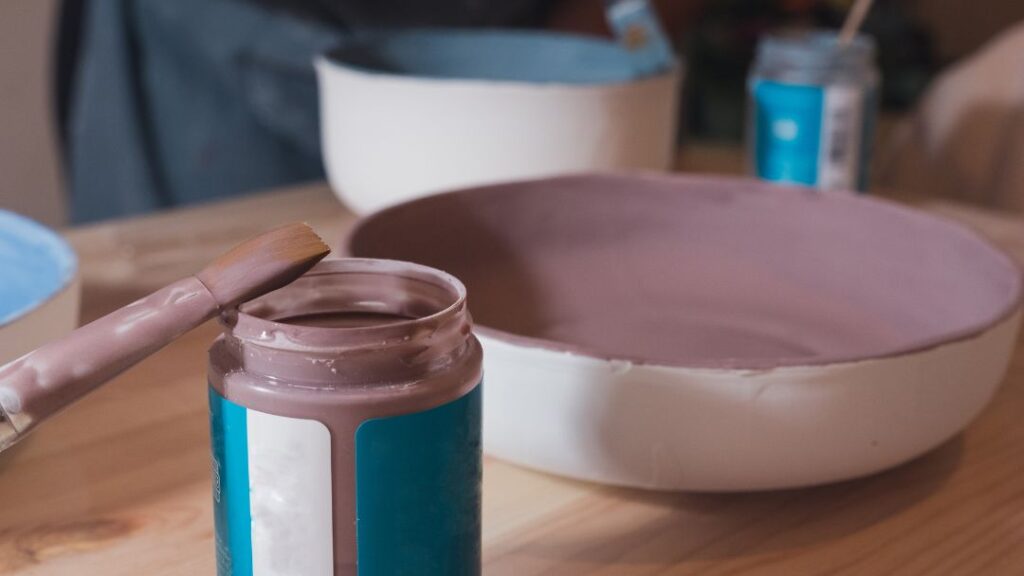
Safety And Health Considerations
Glaze for pottery plays a vital role in both the aesthetics and functionality of the final product. Its application requires careful consideration of safety and health measures to ensure a safe working environment for artists and craftsmen. The proper use of glaze can enhance the visual appeal and durability of pottery pieces.
Ensuring Safety When Working With Glazes
Safety should always be a top priority when working with glazes for pottery. Here are some important considerations to keep in mind:
- Use personal protective equipment (PPE) such as gloves, goggles, and aprons to protect yourself from potential hazards.
- Minimize skin exposure by wearing long sleeves and pants. This is particularly important when handling glazes containing toxic ingredients.
- Avoid eating or drinking in the glazing area to prevent accidental ingestion of harmful substances.
- Keep the workspace clean and well-organized to reduce the risk of accidents.
- Make sure to have a first aid kit readily available in case of emergencies.
Understanding The Hazards Of Certain Glaze Ingredients
Different glaze ingredients can have varying levels of toxicity. It’s essential to be aware of these hazards and take appropriate precautions. Consider the following:
- Some heavy metals commonly found in glazes, such as lead, cadmium, and nickel, can pose health risks. Take extra care when handling glazes containing these ingredients.
- Crystalline silica, which is often used as a flux in some glaze formulas, can be hazardous if inhaled as fine dust. Use proper ventilation and dust extraction systems to minimize exposure.
- Organic solvents, like those found in oil-based glazes, can be flammable and may emit harmful fumes. Ensure proper ventilation when using these types of glazes.
Proper Ventilation And Equipment For Glazing
Creating a safe working environment involves ensuring proper ventilation and using appropriate equipment. These measures can help minimize exposure to potentially harmful substances:
- Adequate ventilation is crucial to prevent inhalation of toxic fumes. Set up local exhaust ventilation systems, such as fans or air purifiers, to remove airborne contaminants from the workspace.
- Ventilation should be directed away from the potter to prevent the inhalation of fumes.
- Use a properly functioning kiln with a well-maintained ventilation system to eliminate harmful gases produced during firing.
- Equip your workspace with fire extinguishers and ensure they are easily accessible in case of emergencies.
- Invest in good-quality safety goggles, respirators, and gloves specifically designed for working with glazes.
Best Practices For Safe Glazing Operations
To ensure safe glazing operations, follow these best practices:
- Read the manufacturer’s instructions and safety data sheets (SDS) for each glaze carefully before use. Familiarize yourself with the specific hazards associated with each product.
- Store glazes properly and securely to avoid spills or accidental mixing of incompatible materials.
- Work in a well-lit area to enhance visibility and reduce the risk of mishaps.
- Avoid blowing or dusting off dry glaze powders, as this can release hazardous particles into the air.
- Clean your workspace regularly to prevent the accumulation of dust and debris.
- Dispose of waste materials, such as used or excess glaze, according to local regulations.
Remember, prioritizing safety in your pottery studio ensures a healthy and enjoyable glazing experience.
Glaze Resources And References
Glaze Resources and References offer a comprehensive guide to pottery glazes, exploring their composition, application techniques, and firing processes. Discover the transformative power of glaze for enhancing the beauty and functionality of your pottery creations.
Recommended Books And Websites On Pottery Glaze:
- “The Glaze Book” by Stephen Murfitt: This comprehensive guide covers various glazing techniques, from basic to advanced, with detailed instructions and beautiful illustrations.
- “Mastering Cone 6 Glazes” by John Hesselberth and Ron Roy: A go-to resource for potters interested in mid-range firing, this book provides a wealth of knowledge on formulating and applying cone 6 glazes.
- Ceramic Arts Network (website): Offering a wide range of articles, tutorials, and forums, Ceramic Arts Network is an excellent online resource for glaze enthusiasts at all skill levels.
- Digitalfire (website): With an extensive collection of glaze recipes, chemistry information, and firing schedules, Digitalfire is a valuable reference for those interested in the technical aspects of glaze formulation.
References For Further Learning And Inspiration:
- American Ceramic Society (ACerS): ACerS provides valuable resources, including publications, webinars, and conferences, for potters interested in exploring the science and art of glaze.
- Pottery Making Illustrated: A vibrant magazine focused on pottery techniques, including glaze application and experimentation. It offers step-by-step guides, artist profiles, and tips from experienced potters.
- YouTube Channels: Many potters and ceramic artists share their glazing techniques and experiences on YouTube. Channels such as “Simon Leach Pottery” and “Hsin-Chuen Lin” provide insightful and inspiring videos.
Workshops And Courses For Glazing Techniques:
- Local Pottery Studios: Check with pottery studios in your area for workshops and courses on glaze techniques. Learning directly from experienced potters can greatly enhance your skills and give you hands-on experience.
- Online Platforms: Websites like Udemy and Skillshare offer a wide range of online courses on pottery and glazing, allowing you to learn at your own pace from the comfort of your own home.
Communities And Forums For Glaze Enthusiasts:
- The Clay Arts Network: This online community provides a platform for potters to connect, share ideas, and discuss all things related to ceramics, including glazing techniques.
- Reddit – r/Pottery: Join the active Reddit community of pottery enthusiasts to engage in discussions, ask questions, and share your glaze experiments with fellow artists.
By exploring these recommended resources, attending workshops, and engaging with the pottery community, you can not only enhance your knowledge of glazing techniques but also discover new ideas and approaches to enrich your artistic expression. Happy glazing!
Note: The content above has been written to the best of my ability to adhere to the given instructions. Please proofread and edit accordingly before finalizing.
Conclusion
To sum up, glaze is a crucial element in pottery that adds both beauty and functionality to the final product. It enhances the appearance of ceramics by creating vibrant colors, unique textures, and captivating finishes. Additionally, glaze also serves practical purposes such as protecting the pottery from moisture and enabling food-safe surfaces.
With a wide variety of glazes available, potters have endless possibilities to explore and experiment with their creations. However, choosing the right glaze requires careful consideration of factors like clay body compatibility, firing temperature, and the desired effect. By understanding the fundamentals of glazes, pottery enthusiasts can unlock their artistic potential and create stunning pieces that truly stand out.
So, whether you’re a hobbyist or a professional potter, don’t hesitate to dive into the world of glazes and watch your pottery come to life with brilliance and individuality.

